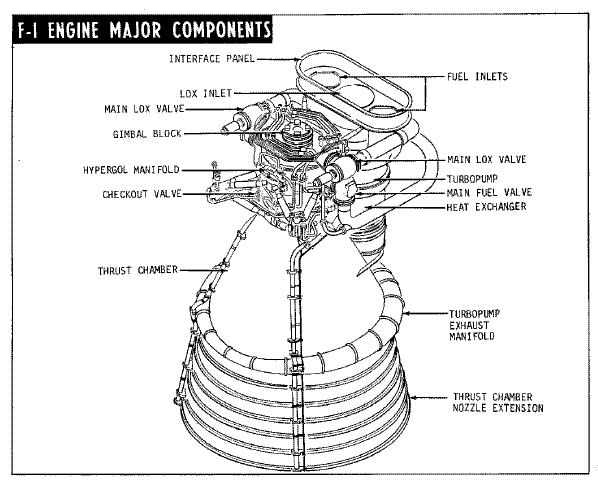The F-1 rocket engine was a critical element in sending men to the Moon. Five of these engines powered the first stage of the Saturn V rocket, which propelled the Apollo spacecraft to the moon. Burning for 167 seconds, the first stage accelerated the rocket to a speed of 6,000 miles per hour and an altitude of 38 miles before falling away and sinking in the Atlantic Ocean. It was said at the time that, except for a nuclear explosion, the launching of the Saturn V was the loudest noise made by man.
The most powerful liquid-fueled rocket engine ever made, each F-1 engine burned three tons of fuel and oxidizer every second to produce 1.5 million pounds of thrust.

The top of the engine contains fuel and oxidizer manifolds that feed into the turbopump. The turbopump was driven by 1,200°F gases passing through a turbine, driving the simultaneous pumping of kerosene fuel at 70°F and liquid oxygen at -300°F to the burner plate. The burner plate had a series of small holes that ejected the fuel and oxidizer in a spray pattern for efficient combustion. Once the engine was ignited, the combustion was self-sustaining. Thrust was generated in the bell shaped thrust chamber, whose sides were protected from the 5,800°F exhaust gasses by running fuel through small tubes on the sides of the chamber. Besides cooling the thrust chamber, this also provided pre-heating to the fuel. At the bottom of the thrust chamber, a bolt-on nozzle extension was fitted. The nozzle extension added about three more feet to the length of the engine, and increased the expansion ratio from 10:1 to 16:1.
The F-1 displayed at the Cosmosphere does not have the nozzle extension, but it is mounted on a stand at the height it would be if the nozzle extension were fitted. This is really an advantage, because it allows you to look up inside the engine and observe the thrust chamber cooling tubes and the burner plate (see photo, "Inside the Nozzle" below). On the burner plate, you may notice copper baffles in circular and radial patterns extending down from the plate. They helped to stop runaway instability during combustion.
To log this cache:
1. It is not necessary to pay admission for the museum in order to log the cache, but you must actually visit the site.
2. To open the Certificate of Accomplishment, go to the indicated position in front of the F-1 display and look at the plaque at the foot of the center flagpole. (You might need to sweep off snow in winter.) The password is the surname on the plaque. The case of the password (i.e., upper or lower case) is the way your English teacher taught you to capitalize a proper name.
3. If the password opens the certificate, you may log this cache as a find. DO NOT INCLUDE A COPY OF THE CERTIFICATE IN YOUR LOG. If the certificate does not open, e-mail me with the password.
4. Logs that do not follow these procedures, or that appear to be fraudulent, will be deleted without comment.

Certificate